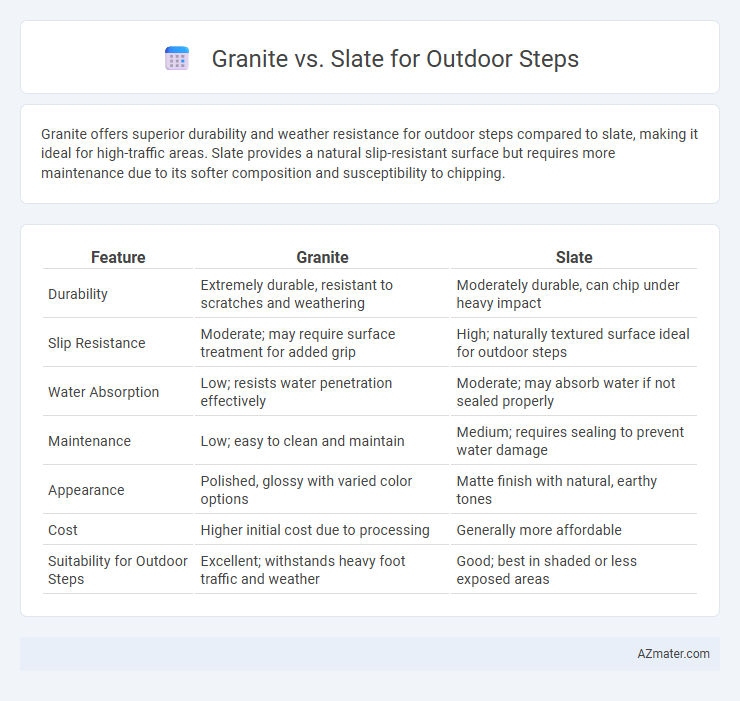Granite offers superior durability and weather resistance for outdoor steps compared to slate, making it ideal for high-traffic areas. Slate provides a natural slip-resistant surface but requires more maintenance due to its softer composition and susceptibility to chipping.
Table of Comparison
| Feature | Granite | Slate |
|---|---|---|
| Durability | Extremely durable, resistant to scratches and weathering | Moderately durable, can chip under heavy impact |
| Slip Resistance | Moderate; may require surface treatment for added grip | High; naturally textured surface ideal for outdoor steps |
| Water Absorption | Low; resists water penetration effectively | Moderate; may absorb water if not sealed properly |
| Maintenance | Low; easy to clean and maintain | Medium; requires sealing to prevent water damage |
| Appearance | Polished, glossy with varied color options | Matte finish with natural, earthy tones |
| Cost | Higher initial cost due to processing | Generally more affordable |
| Suitability for Outdoor Steps | Excellent; withstands heavy foot traffic and weather | Good; best in shaded or less exposed areas |
Introduction to Granite and Slate for Outdoor Steps
Granite offers exceptional durability and resistance to weathering, making it ideal for outdoor steps that require long-lasting structural integrity. Slate provides a natural slip-resistant surface with unique texture variations, enhancing safety and aesthetic appeal in outdoor environments. Both materials withstand harsh outdoor conditions but differ in maintenance needs and visual style, influencing step design decisions.
Key Material Properties: Granite vs Slate
Granite offers superior hardness and durability with a Mohs scale rating of 6-7, making it highly resistant to scratches and weathering, ideal for high-traffic outdoor steps. Slate, rated around 3.5-4 on the Mohs scale, provides a natural cleft texture and excellent slip resistance but is more prone to chipping and weather-induced wear over time. Both materials resist water absorption effectively, but granite's higher density makes it less susceptible to frost damage and long-term erosion in outdoor environments.
Durability and Weather Resistance
Granite offers superior durability and weather resistance for outdoor steps due to its dense, hard composition, which withstands heavy foot traffic, freeze-thaw cycles, and UV exposure without significant wear. Slate, while visually appealing and naturally slip-resistant, is softer and more prone to chipping and weather-induced erosion, requiring regular maintenance to preserve its integrity. For long-lasting, low-maintenance outdoor steps exposed to harsh climates, granite is the optimal choice.
Aesthetic Appeal and Color Variations
Granite offers a wide range of color variations from deep blacks to vibrant pinks, enhancing outdoor steps with its polished and consistent texture that exudes elegance and timeless appeal. Slate boasts rich, earthy tones such as greens, blues, and greys, providing a natural, layered aesthetic that adds rustic charm and a slip-resistant surface ideal for outdoor environments. Both stones deliver durability, but the choice between granite's glossy finish and slate's matte, textured look significantly influences the visual impact of outdoor steps.
Slip Resistance and Safety Factors
Granite offers superior slip resistance for outdoor steps due to its naturally rough texture and durability, making it a safer option in wet or icy conditions. Slate, while aesthetically appealing with its layered structure, can become slippery when polished or exposed to moisture, posing potential safety risks. Choosing granite ensures enhanced grip and long-term safety, especially in high-traffic or exposed outdoor environments.
Installation Process and Maintenance
Granite outdoor steps require professional installation due to their heavy weight and need for precise cutting, ensuring durability and a seamless finish. Slate steps, while also benefiting from professional installation, offer easier cutting and lighter weight, allowing for more DIY-friendly placement but may require meticulous sealing to prevent moisture damage. Maintenance for granite steps involves occasional cleaning and resealing every few years to retain their polished look, whereas slate demands more frequent sealing and vigilance against chipping or flaking in harsh weather conditions.
Cost Comparison: Granite vs Slate
Granite typically costs between $40 and $75 per square foot, making it a more expensive option compared to slate, which ranges from $30 to $60 per square foot for outdoor steps. Installation costs for granite can be higher due to its density and weight, requiring specialized tools and labor compared to slate's comparatively easier handling. While granite offers durability that may reduce long-term maintenance expenses, slate's lower upfront cost provides a budget-friendly choice for outdoor steps without compromising aesthetic appeal.
Environmental Impact and Sustainability
Granite and slate differ significantly in their environmental impact and sustainability for outdoor steps. Granite extraction involves energy-intensive quarrying and generates substantial mineral waste, but its exceptional durability ensures long-term use, reducing replacement frequency. Slate mining has a lower carbon footprint, with minimal processing and waste, and offers natural weather resistance, making it a sustainable choice for eco-conscious outdoor applications.
Best Applications for Each Stone Type
Granite's durability and resistance to weathering make it ideal for outdoor steps exposed to heavy foot traffic and harsh climates, providing long-lasting strength and slip-resistant surfaces. Slate offers a natural cleft texture and excellent water resistance, making it suitable for decorative outdoor steps in shaded or moist environments where aesthetic appeal and moderate durability are priorities. Both stones excel in different applications: granite for high-use, rugged conditions, and slate for visually appealing, moderate-use outdoor areas.
Conclusion: Choosing the Right Stone for Outdoor Steps
Granite offers exceptional durability and resistance to weathering, making it ideal for high-traffic outdoor steps exposed to harsh conditions. Slate provides a natural slip-resistant surface with unique aesthetic textures, suitable for areas prioritizing style and moderate foot traffic. Selecting the right stone depends on balancing granite's long-lasting strength with slate's distinct appearance and traction benefits for outdoor step applications.

Infographic: Granite vs Slate for Outdoor Step
 azmater.com
azmater.com